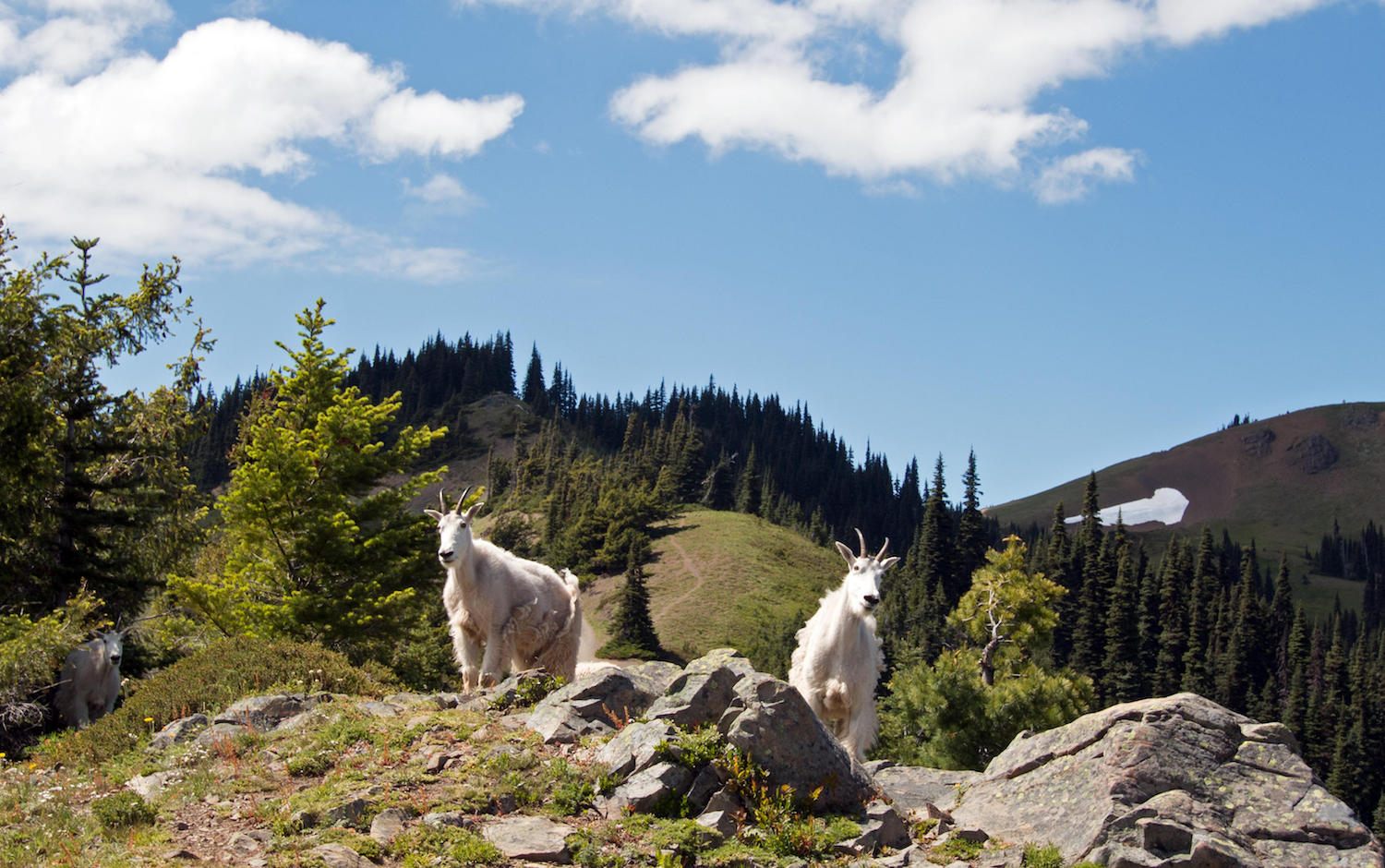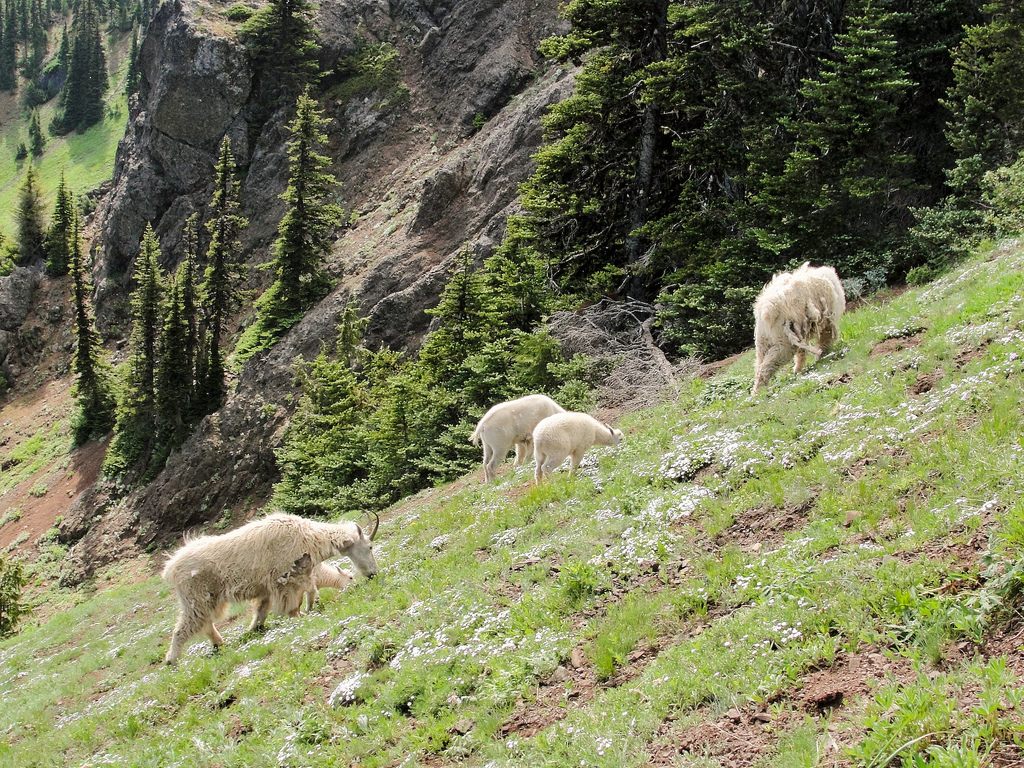Why Helicopters Are Flying Mountain Goats Over Washington State
The salt-loving, tourist-stalking goats of Olympic National Park are moving out.

On a recent Tuesday in Olympic National Park, the clear blue skies of Washington State were interrupted by a series of white, fluffy objects. Some of them were clouds, yes. But three of them were mountain goats, flying through the air. The huge, shaggy creatures were suspended in orange slings, wearing blindfolds that fit snugly beneath their horns. They were dangling vertically from a helicopter, like a string of peppers hung out to cure.
Olympic National Park—a 1442-square-mile expanse of mountains, meadows, and old-growth forest—is the rightful home of dozens of creatures. Spotted owls nest in its trees. Black bears trundle through its fields. Mazama pocket gophers burrow into its soils, and Roosevelt elk munch on its shrubs.
But it is not the rightful home of the mountain goat. At least, so say park officials, who have been trying to get rid of the goats—an introduced species—for decades. Last week, in collaboration with the USDA Forest Service and the Washington Department of Fish and Wildlife, they began their latest, and most ambitious, removal effort.
If all goes well, over the next couple of years, hundreds of mountain goats will travel by helicopter and truck from Olympic National Park to the North Cascade Mountains, about 150 miles east. (There’s a naturally occurring goat population in the Cascades, and the hope is that these newcomers will bolster it.) Eventually, goats that are too hard to capture will be killed. “The goal is to get to a zero population level,” says park spokesperson Penny Wagner.
Until about 1925, there were zero mountain goats on the Olympic Peninsula. The first four came to the area in 1925, brought over from British Columbia as game for local hunters. Over the next few years, these were joined by seven or eight more, this time shipped in from Alaska. While hunters did kill a fair number, the frisky goats outpaced them. By the early 1980s, this herd of a dozen had grown to 1,175.
Goats will be goats, wherever they are, and these ones have caused some trouble. They’ve trampled plants, including imperiled species like the cotton’s milkvetch, a flowering legume found only in Washington State. While wallowing—a common mammalian pastime that involves rolling around in the dirt—they’ve disturbed archaeological sites. (Once, according to a National Park Services report, these goaty gyrations “resulted in previously unknown archaeological resources being unearthed.”)

Not least, they tend to stalk tourists. Sodium and similar minerals make up a vital part of the ungulate diet, but Olympic National Park lacks natural salt licks. Though goats have been known to travel many miles for a fix, it’s much easier to just follow humans, who, thanks to our constant production of sweat and urine, are practically saltshakers.
After years of coexisting with people, the park’s goats have no qualms about interrupting a bathroom break, or chewing the armpits of exercise clothes left to air out near a campsite. “They’ve lost that normal wariness,” says Wagner. Legend has it that, while resting during a long hike, former superintendent Bob Chandler opened his eyes to find his scalp being tongued by a brazen billy.
Such close encounters can be dangerous. In 1999, a group of picnickers on top of Mount Ellinor caught the attention of a salt-hungry goat, who stabbed one of them in the leg with his horn. And in 2010, a hiker was fatally gored after a goat followed him for about a mile. (Soon after, park officials asked visitors to stop peeing alongside trails “in areas of high goat use,” and there is also an extensive “Goats And Your Safety” section on the park website.)

The tourists certainly aren’t going to leave the park. Neither are the plants or the archaeological treasures. And so for years, officials have focused on getting out the goats. The 1980s and ’90s saw several different attempts: From 1988 to 1989, “goats were darted, sling-loaded and packed in snow and cocktail ice for road trips to areas where they would not be considered an “unwelcome addition,’” writes Helen Carolyn Wagenvoord in a 1995 report. (Because they’re mountain goats, they prefer refrigerated transport.)
But some goats were very difficult to capture—after all, they can scale cliffs—and the attempts proved dangerous for everyone. Officials ended up abandoning the efforts before they were complete. Thanks to pushback from the public, and from animal rights groups, they decided not to move on to lethal removal.
By the time summer 2018 came around, the tide had shifted. The Final Mountain Goat Management Plan privileges relocation until “a point of diminishing returns” is reached. After that, lethal removal will begin. Although civilians expressed some concerns, “public meetings were hardly boisterous affairs, and major conservation organizations, biologists and other government agencies have supported the park’s efforts,” writes Evan Bush, who covers the mountain goat beat for the Seattle Times. (Wagner chalks this up to inter-agency collaboration, as well as the 2010 goring, which she says may have driven home “the reality of the situation.”)

The translocation stage started on Monday, September 10. As Bush reports, teams in helicopters track down goats in the park and shoot them with sedative-loaded darts or net guns. Next, “a handler known as a mugger jump[s] from the helicopter, calm[s] the animals and attache[s] them to a sling,” Bush writes.
The blindfolded, dangling goats are flown to a clearing and lowered into a flatbed truck. While the use of helicopters may seem overly dramatic, they’re actually a common wildlife transport tool: Over the past few years, copters have relocated bighorn sheep to their native ranges in Oregon, brought rehabilitated grizzly cubs back into the wild, and ferried endangered black rhinos in South Africa from a poaching-heavy area to a protected reserve.
By this past Monday, September 17, 62 goats had been captured, despite weekend rains that hampered the operation, says Wagner. After their helicopter trip, they get driven to a staging area, where they’re checked out by a team of veterinarians.
They take a six-hour truck ride to the North Cascades, and stay overnight in another staging area. After that, they’re set free, guided through a corral of temporary fencing into the wilderness beyond. “The goal is to have them released within 24 hours,” she says. “As quickly and efficiently as possible, to minimize the impact of the whole deal.” Translocation will stop this coming Friday, and start again sometime in 2019.
In videos, the released goats stumble a bit. Some get stuck on shrubs. A few are reluctant to leave their crates. (Fish and Wildlife workers encourage them, saying “c’mon, boy.”) They now have a new job: helping to increase the population in the Cascades, where they actually are native. This will bring with it new challenges, including natural predators like cougars and golden eagles, not to mention those old nemeses, human hunters. But for now, they’re probably just happy to be back on the ground.











Follow us on Twitter to get the latest on the world's hidden wonders.
Like us on Facebook to get the latest on the world's hidden wonders.
Follow us on Twitter Like us on Facebook